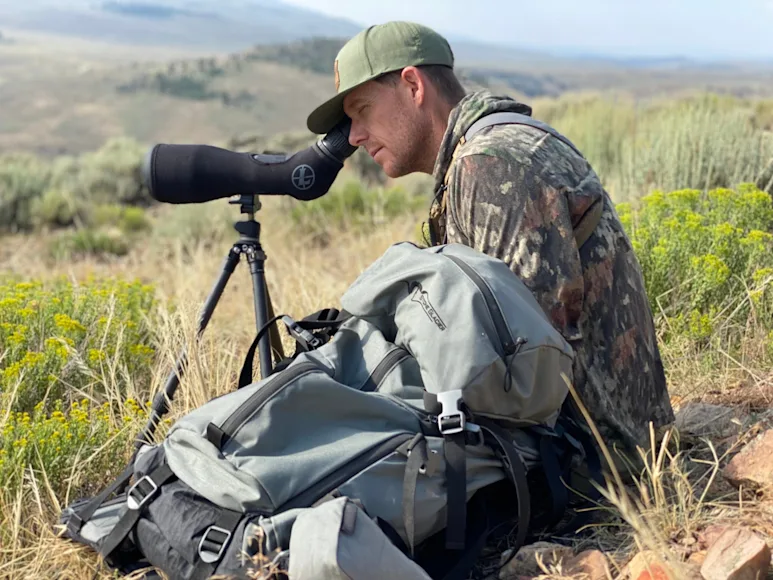_We may earn revenue from the products available on this page and participate in affiliate programs. Learn more ›
_
Best Overall
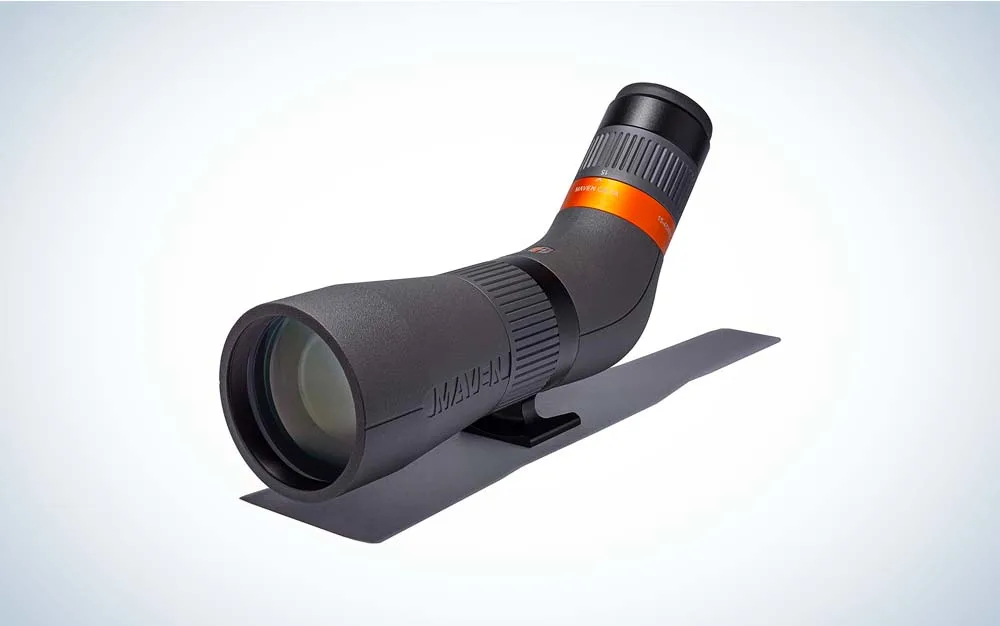
Maven CS.1A – 15-45×65
Best Compact

Vortex Razor HD 11-33×50 Angled
Most Durable
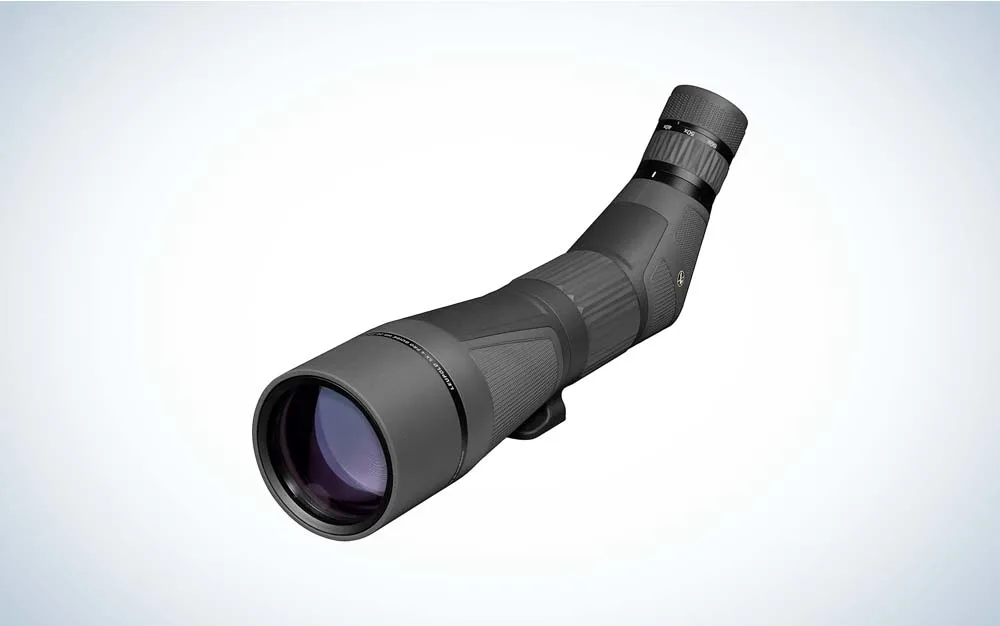
Leupold SX-4 Pro Guide HD 20-60×85 Angled
I always used my 10×42 binoculars to spot western critters, and I never had a problem doing so. It wasn’t until I was hunting with my good buddy and stone-cold elk killer, Grafton Singer, that I finally saw what a great spotting scope could do. We were in the high-country scouting for velvet-racked bulls, and on a particular evening when the western sky started draining the day’s light, I heard, “Got another one.” Two minutes would pass, and then, “Found another herd.” It went on like that for a half-hour.
The following day was more of the same, and I was unable to stand it anymore, so I put an eye into Singer’s spotter to enjoy the view. Next, Singer attached his PhoneSkope
to the eyepiece of his spotting scope and started taking pictures and videos of the different bulls. That morning proved to be a fantastic experience in the elk woods.
Now I don’t go into the western woods without a good spotter. I still use my 10- or 12-power binos to find most of my game, but once spotted, the scope and tripod come out, and the debate about trophy potential and possible stalking routes begins. Many hunters shy from spotting scopes due to price, and while there are many models on the market that create serious sticker shock, there are some excellent affordable options. Here are the best spotting scopes under $1000.
Best Overall: Maven CS.1A – 15-45×65
Best Compact: Vortex Razor HD 11-33×50 Angled
Best Straight View: Snypex Knight T80 ED-APO 20-60×80
Most Durable: Leupold SX-4 Pro Guide HD 20-60×85 Angled
Best Value: Hawke Nature-Trek System H2 16-48×65
How We Made Our Picks
Many hunts that require the use of a spotting scope mean serious planning, physical training, extra logistics, and, often, a pricy tag
. These hunts are also usually spot-and-stalk adventures—the keyword being “spot.” You can’t stalk what you can’t see, and you can’t make accurate judgments about the size of the critter if the spotter is sub-par. I have tested each of the following spotting scopes across the West while glassing for pronghorn, elk
, and Rocky Mountain big horn sheep
. Each cracks our list for the best spotting scopes under $1000, and all promise excellent magnification, solid light gathering, a rugged build, and remarkable color fidelity.
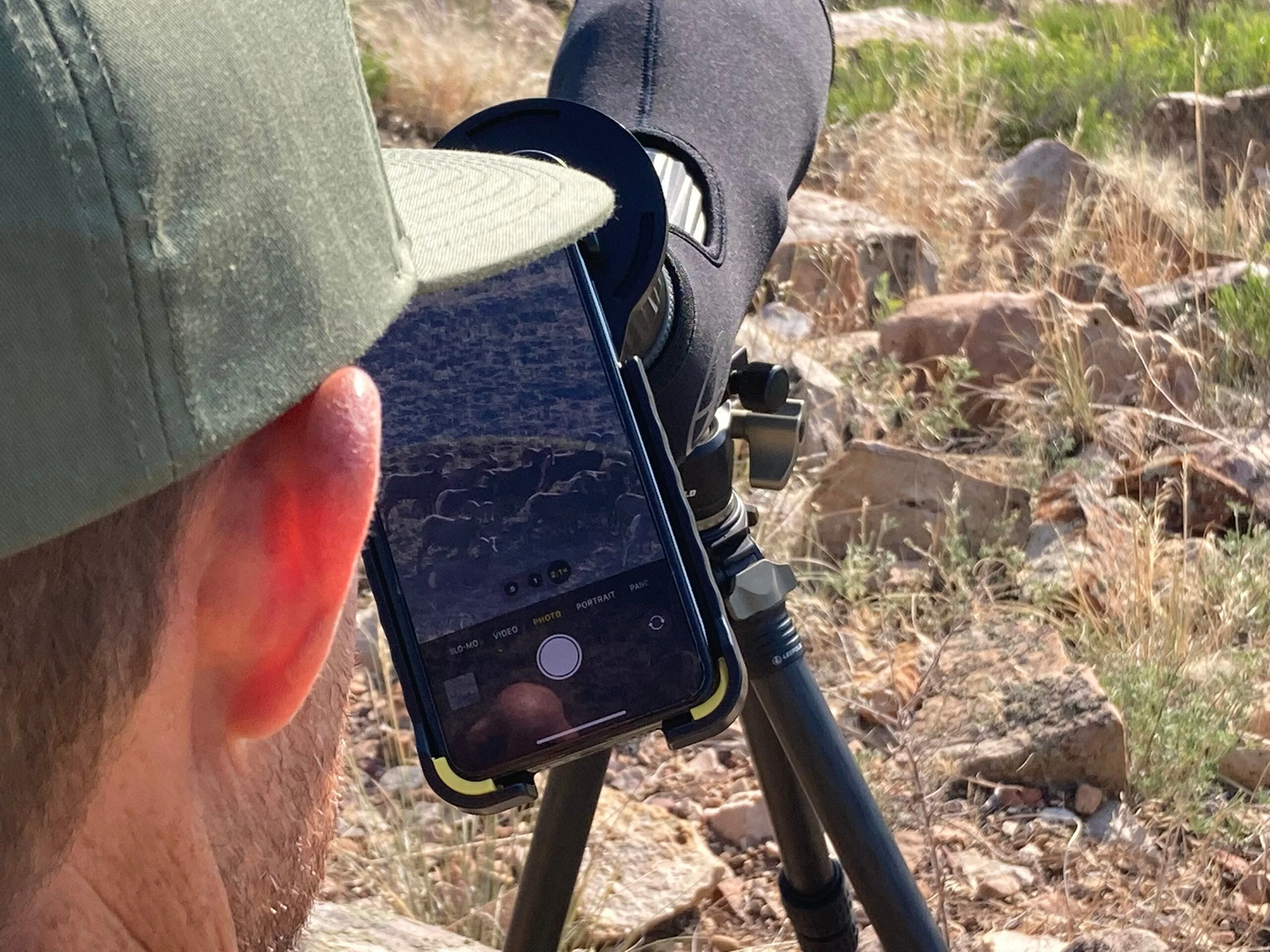
Adding a PhoneSkope to your spotter is a great way to capture images and video of game. Jace Bauserman
Best Spotting Scopes Under $1000: Reviews & Recommendations
Best Overall: Maven CS.1A – 15-45×65

Specs
Weight: 40.4 ounces
Length: 11.4 inches long
Magnification: 15-45
Pros
Excellent detail at extended distances
Extra-low dispersion ED glass
Fully multi-coated lenses
Lens cap & double-layer microfiber storage bag
Cons
Single focus
Maven’s optical C Series is a winner, and this spotter is an excellent addition. The CS.1A uses the same award-winning glass as Maven’s C Series binoculars and would be a great addition to any backpack’s spotting scope pocket. The aluminum frame is lightweight but highly durable, the eyepiece is comfortable, and the focus wheel is smooth and precise. Images, no matter the lighting condition, appear bright and sharp, and users will be impressed with how the glass makes colors pop. This is a great all-around spotter, is water and fog-proof, and comes with Maven’s Lifetime Warranty. No matter the animal or the situation, this spotting scope will meet and exceed your expectations.
Best Compact: Vortex Razor HD 11-33×50 Angled

Specs
Weight: 25 ounces
Length: 10.3 inches long
Magnification: 11-33
Pros
APO lens system
ArmorTec
Compact
HD lens elements
Cons
Limited magnification
Though the 11-33 magnification range isn’t mighty, this angled spotter has much going for it. Sleek and functional, the Razor HD ensures distortion-free glassing. ArmorTec married with Vortex’s APO System means maximum lens protection and index-matched lenses that correct color across the entire visual spectrum. The focus wheel is silk, and the spotter’s Plasma Tech coating means lifelong durability in an optic that can perform in any environment season after season. The magnification and focusing wheel are placed well on the scope and offer smooth but not too loose movement.
Best Straight View: Snypex Knight T80 ED-APO 20-60×80
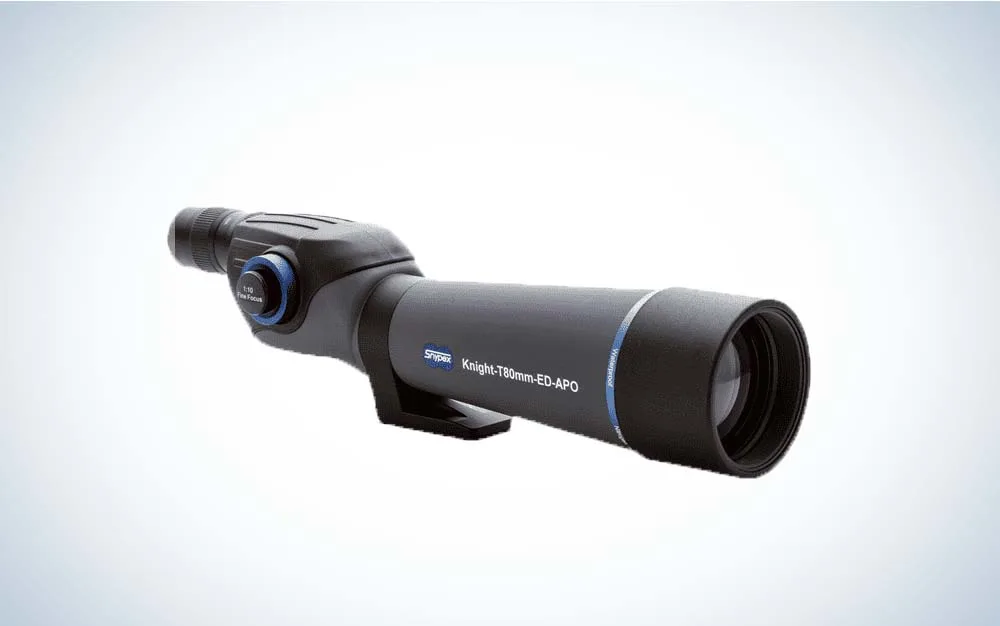
Specs:
Weight: 73.476 ounces
Objective Lens: 80mm
Magnification: 20-60
Pros:
Dual speed focusing
ED glass
APO lens
Affordable
Cons:
Heavy
Doesn’t fit well in a pack’s spotting scope pocket
Those wanting a straight spotting scope design need to look no further than Snypex’s Knight T80 ED-APO 20-60×80. Aside from being a tad on the heavy side, this spotter balances remarkably well on a sturdy tripod. The dual-speed focusing allows the user to establish the subject remarkably fast. The clarity of the spotting scope is remarkable, and if I were strictly looking for a spotter to judge animals, this one would be high on my list. The glass has extra-low dispersion (ED) elements that ensure fantastic imagery regardless of outside lighting, and the spotting scope is water and fog-proof. This spotter isn’t the most packable, but it does come with a portable soft bag. The wide and long spotting scope attachment plate help boost the functionality when attached to a top-end tripod.
Most Durable: Leupold SX-4 Pro Guide HD 20-60×85 Angled

Specs
Weight: 78.2 ounces
Length: 17.7 inches
Magnification: 20-60
Pros
Built like a tank
Great magnification
Elite optical system
Oversized eyepiece & twist-up eyecup
Cons
Heavy
This spotter just squeaks into the lineup right at the $1000 mark. If you put a premium on clarity, magnification, and durability, then the SX-4 Pro Guide is for you. The SX-4 Pro Guide is designed to handle any environment and the worst conditions Mother Nature can muster. Dawn-to-dusk light transmission is fantastic, and when the sun is high and heat weaves form, you’ll appreciate the scope’s ability to reduce glare and allow you the opportunity to concentrate on the task at hand and find more game. Leupold tested this spotting scope in temperatures as low as 40 degrees below Fahrenheit and as high as 160 degrees above Fahrenheit—and it came out on top every time. The spotter is also waterproof and fog-proof and is guaranteed for life.
Best Value: Hawke Nature-Trek System H2 16-48×65
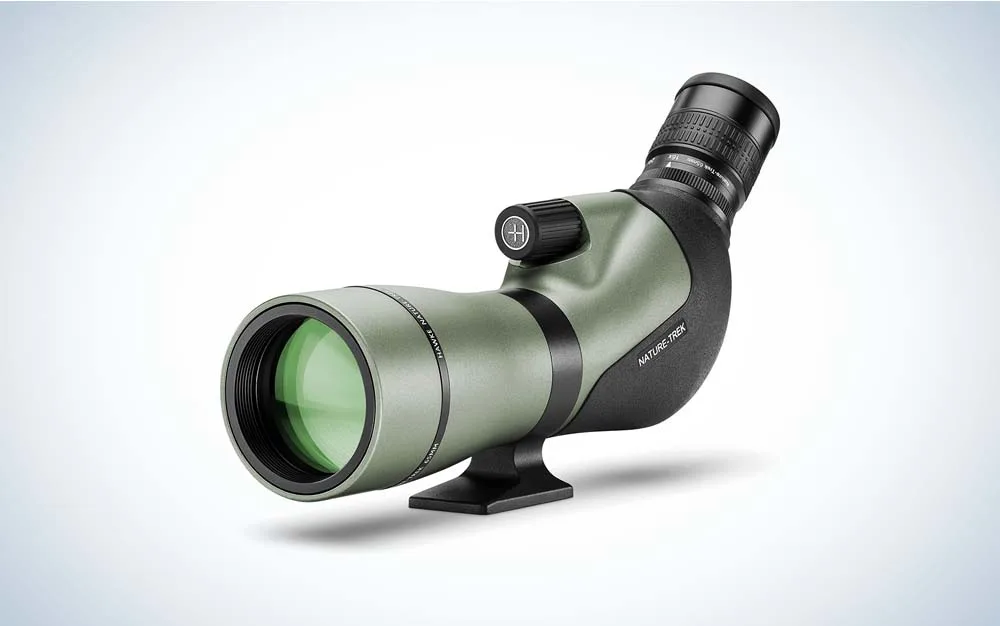
Specs
Weight: 41.8 ounces
Length: 14 inches
Magnification: 16-48
Pros
Price
Fully multi-coated optics
BAK-4 porro prisms
Pull-out sunshade
Cons
Long-range clarity
Single focus
Hawke Optics has made a name for itself with the binocular and riflescope crowd, but make no mistake, its Nature-Trek System H2 spotter is an excellent buy. Under $350, the scope, though not ultra-light, measures only 14 inches long and has a max magnification of 48x. The twist-up eyecups with a pull-out sunshade reduce eye fatigue, and a fully multi-coated optical system blended with BAK-5 Porro prisms sharpen images. The rotating tripod band should also be applauded, and the scope provides close-focus detail. Hawke’s Nature-Trek System H2 16-48×64 comes with a stay-on soft scope cover for added protection and fits nicely into backpacks.
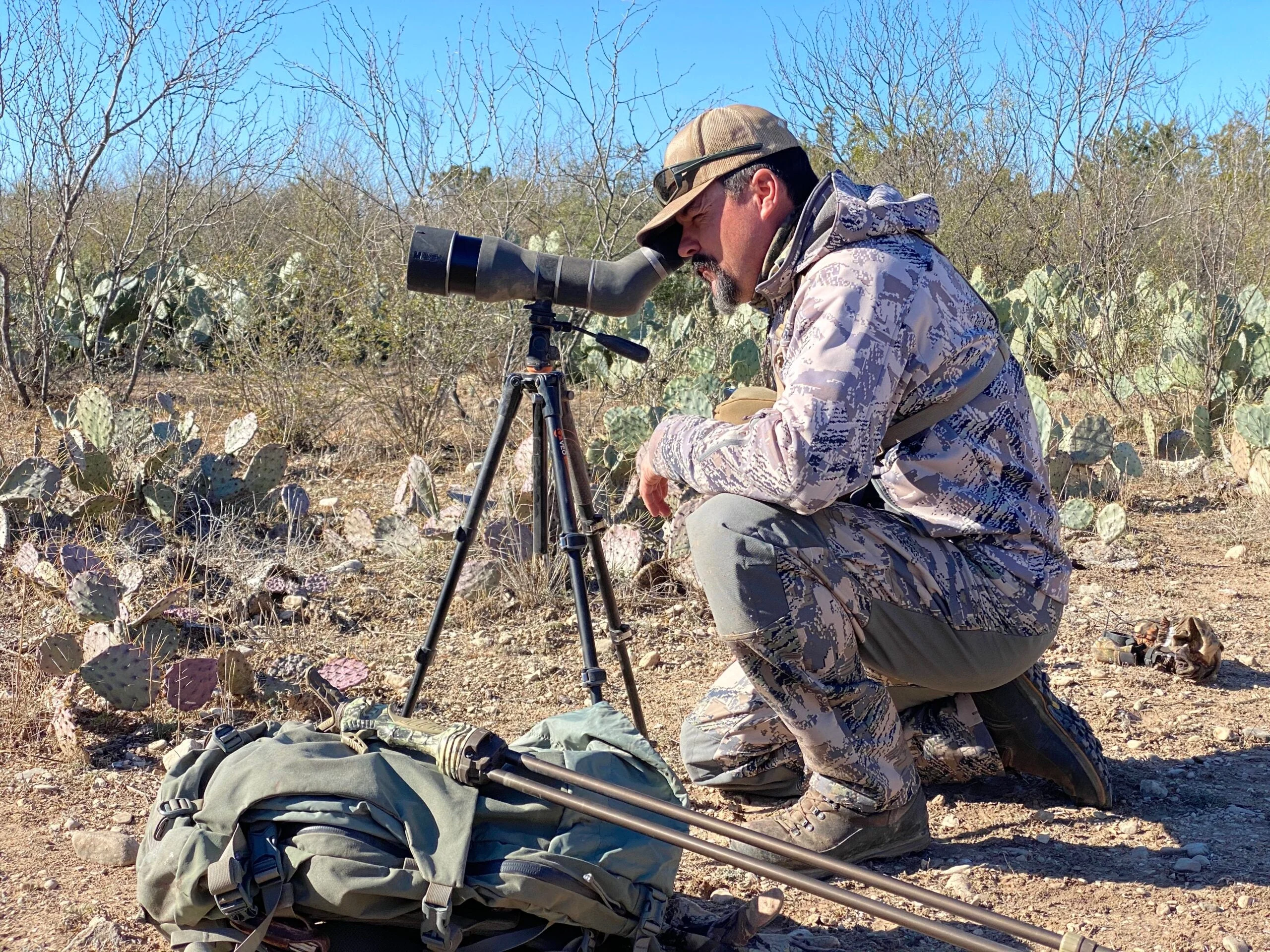
A quality spotting scope can help you locate game at a distance and plan a stealthy stalk. Jace Bauserman
Things to Consider Before Buying a Spotting Scope
If you hunt in the West or any area in the country where the terrain is open, a good spotting scope will save your legs and allow you to spot animals from a distance. Before you buy a spotting scope, you should consider the following factors to make sure you find the best possible optic for your hunt.
Angled or Straight Eyepiece
Spotting scopes usually come in two different models—angled or straight. This refers to the position of the eyepiece. An angled eyepiece will tilt upward towards the hunter’s face allowing them to look down into the scope. A straight eyepiece is a long continuation of the lens, and the user looks directly through it. The downside to a straight spotter is that the user has to be at eye level with the scope. An angled spotter allows the hunter/user to comfortably glass without getting level with the scope. Straight spotting scopes are usually easier to store on the side of a backpack.
Clarity and Magnification
The quality of your glass is going to determine how well you can see game. Buy a spotter with good low-light transmission and glare reduction. This will help find animals in the early morning and late evening when visibility is poor. Having strong magnification will also help you glass areas further away and develop stalking routes. The further and clearer you can see, the better.
Features and Build Quality
Look for spotting scopes that have water and fog-proof capabilities. This will help when the conditions inevitably turn bad on a hunt. Also, look for a strong build quality that has a sturdy and protective housing. Other features like adjustable eyecups and a pull-out sunshade make glassing more comfortable.
Remember Binoculars
It’s important to remember that a spotting scope doesn’t replace binoculars. On most western hunts, I locate game with my 10-power binos and then pull out the spotting scope to further evaluate the animal(s) and plan a stalking approach.
FAQs
Q: What is the best spotting scope for mule deer hunting?
Mule deer inhabit some of the most daunting landscapes in North America. A compact, durable scope with decent magnification and exceptional clarity is essential. The spotter’s eye relief is vital as hunters will spend hours behind the glass.
Q: What is the best spotting scope for a backpack?
An angled or straight spotting scope will both work for backpacks. Straight spotting scopes don’t have the angled eyepiece, so they slide easily into a backpack. Many angled models offer removable eyepieces, making them easier to tote up and down the mountain.
Q: How much do spotting scopes cost?
Some spotting scopes cost more than $5K, and some fall under the $500 mark. Spotting scopes priced between $600 and $1,000 fill a mid-grade niche and offer plenty of quality for most hunting situations. The options listed above are some of the best spotting scopes under $1000.
Q: Do I need a tripod to go with my spotting scope?
Yes. The importance of a balanced, durable, and ultra-adjustable tripod is essential. Trying to use a spotting scope off-hand is not recommended.
Best Spotting Scopes Under $1000: Final Thoughts
Best Overall: Maven CS.1A – 15-45×65
Best Compact: Vortex Razor HD 11-33×50 Angled
Best Straight View: Snypex Knight T80 ED-APO 20-60×80
Most Durable: Leupold SX-4 Pro Guide HD 20-60×85 Angled
Best Value: Hawke Nature-Trek System H2 16-48×65
A spotting scope is a must-have item for the hunter who enjoys zooming in and watching game from afar. With many of today’s advanced smartphone-to-spotter attachment systems, you can take remarkable photos of the game you’re glassing. Trophy hunters looking for animals in a particular age class or those with high-scoring headgear should spend hours judging animals behind an excellent spotting scope before embarking on a stalk. The recommendations above are some of the best spotting scopes under $1000 you can find today, and each will get the job done in the field.

